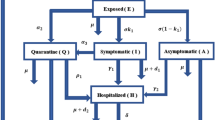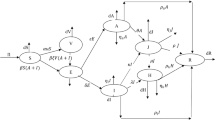Abstract
The widespread of the novel coronavirus (2019-nCoV) has adversely affected the world and is treated as a Public Health Emergency of International Concern by the World Health Organization. Assessment of the basic reproduction number with the help of mathematical modeling can evaluate the dynamics of virus spread and facilitate critical information for effective medical interventions. In India, the disease control strategies and interventions have been applied at the district level by categorizing the districts as per the infected cases. In this study, an attempt has been made to estimate the basic reproduction number R0 based on publically available data at the district level in India. The susceptible-exposed-infected-critically infected-hospitalization-recovered (SEICHR) compartmental model is constructed to understand the COVID-19 transmission among different districts. The model relies on the twelve kinematic parameters fitted on the data for the outbreak in India up to May 15, 2020. The expression of basic reproduction number R0 using the next-generating matrix is derived and estimated. The study also employs three time-dependent control strategies to control and minimize the infection transmission from one district to another. The results suggest an unstable situation of the pandemic that can be minimized with the suggested control strategies.
Access this chapter
Tax calculation will be finalised at checkout
Purchases are for personal use only
Similar content being viewed by others
References
Biswas, M. H. A., Haque, M. M., & Mallick, U. K. (2019). Optimal control strategy for the immunotherapeutic treatment of HIV infection with state constraint. Optimal Control Applications and Methods, 40(4), 807–818.
Diekmann, O., Heesterbeek, J. A. P., & Metz, J. A. (1990). On the definition and the computation of the basic reproduction ratio R0 in models for infectious diseases in heterogeneous populations. Journal of Mathematical Biology, 28(4), 365–382.
Duhoe, A. A. A., & Toffa, B. A. (2020). COVID-19: A blessing or curse on affected countries and its citizens. Research Journal in Advanced Social Sciences, 1, 32–39.
Garba, S. M., Gumel, A. B., & Bakar, M. A. (2008). Backward bifurcations in dengue transmission dynamics. Mathematical Biosciences, 215(1), 11–25.
Giordano, G., Blanchini, F., Bruno, R., Colaneri, P., Di Filippo, A., Di Matteo, A., & Colaneri, M. (2020). Modelling the COVID-19 epidemic and implementation of population-wide interventions in Italy. Nature Medicine, 26, 1–6. https://doi.org/10.1038/s41591-020-0883-7.
Ivorra, B., Ferrández, M. R., Vela-Pérez, M., & Ramos, A. M. (2020). Mathematical modeling of the spread of the coronavirus disease 2019 (COVID-19) taking into account the undetected infections. The case of China. Communications in Nonlinear Science and Numerical Simulation, 88, 105303. https://doi.org/10.1016/j.cnsns.2020.105303
Kao, R. R. (2002). The role of mathematical modelling in the control of the 2001 FMD epidemic in the UK. Trends in Microbiology, 10(6), 279–286.
Keeling, M. J., & Danon, L. (2009). Mathematical modelling of infectious diseases. British Medical Bulletin, 92(1), 33–42.
Lancet, T. (2020). India under COVID-19 lockdown. Lancet, 395(10233), 1315. https://doi.org/10.1016/S0140-6736(20)30938-7.
Lloyd, A. L. (2001). Destabilization of epidemic models with the inclusion of realistic distributions of infectious periods. Proceedings of the Royal Society of London. Series B: Biological Sciences, 268(1470), 985–993.
Miller, L. E., Bhattacharyya, R., & Miller, A. L. (2020). Spatial analysis of global variability in Covid-19 burden. Risk Management and Healthcare Policy., 13, 519–522.
Mohanty, S. K. (2020). Contextualising geographical vulnerability to COVID-19 in India. The Lancet Global Health, 8(9), 1104–1105.
Mondal, M. K., Hanif, M., & Biswas, M. H. A. (2017). A mathematical analysis for controlling the spread of Nipah virus infection. International Journal of Modelling and Simulation., 37(3), 185–197.
Peirlinck, M., Linka, K., Costabal, F. S., & Kuhl, E. (2020). Outbreak dynamics of COVID-19 in China and the United States. Biomechanics and Modeling in Mechanobiology. https://doi.org/10.1007/s10237-020-01332-5.
Pontryagin, L. S. (2018). Mathematical theory of optimal processes. Routledge.
Postnikov, E. B. (2020). Estimation of COVID-19 dynamics “on a back-of-envelope”: Does the simplest SIR model provide quantitative parameters and predictions? Chaos, Solitons & Fractals, 135, 109841.
Prem, K., Liu, Y., Russell, T. W., Kucharski, A. J., Eggo, R. M., Davies, N., et al. (2020). The effect of control strategies to reduce social mixing on outcomes of the COVID-19 epidemic in Wuhan, China: A modelling study. The Lancet Public Health, 5(5), 261–270.
Ranney, M. L., Griffeth, V., & Jha, A. K. (2020). Critical supply shortages—The need for ventilators and personal protective equipment during the Covid-19 pandemic. New England Journal of Medicine, 382(18), e41. https://doi.org/10.1056/NEJMp2006141.
Reiner, R. C., Jr., Perkins, T. A., Barker, C. M., Niu, T., Chaves, L. F., Ellis, A. M., et al. (2013). A systematic review of mathematical models of mosquito-borne pathogen transmission: 1970–2010. Journal of the Royal Society Interface., 10(81), 20120921.
Sattenspiel, L., Lloyd, A. (2009). The geographic spread of infectious diseases: models and applications (Vol. 5). Princeton University Press.
Tuite, A. R., Fisman, D. N., & Greer, A. L. (2020). Mathematical modelling of COVID-19 transmission and mitigation strategies in the population of Ontario, Canada. CMAJ, 192(19), E497–E505.
Wang, M., & Flessa, S. (2020). Modelling Covid-19 under uncertainty: What can we expect? The European Journal of Health Economics, 21, 665–668. https://doi.org/10.1007/s10198-020-01202-y.
World Health Organization. (2020). WHO coronavirus disease (COVID-19) dashboard. https://covid19.who.int/. Accessed 25 July 2020.
Zhang, X., Ma, R., & Wang, L. (2020). Predicting turning point, duration and attack rate of COVID-19 outbreaks in major Western countries. Chaos, Solitons & Fractals, 135, 109829 (2020). https://doi.org/10.1016/j.chaos.2020.109829.
Acknowledgements
All the authors are thankful to DST-FIST file # MSI-097 for technical support to the Department of Mathematics, Gujarat University. The fourth author (AHS) is funded by a Junior Research Fellowship from the Council of Scientific & Industrial Research (file no.-09/070(0061)/2019-EMR-I).
Author information
Authors and Affiliations
Corresponding author
Editor information
Editors and Affiliations
Rights and permissions
Copyright information
© 2021 The Author(s), under exclusive license to Springer Nature Singapore Pte Ltd.
About this paper
Cite this paper
Sikarwar, A., Rani, R., Shah, N.H., Suthar, A.H. (2021). Controlling the Transmission of COVID-19 Infection in Indian Districts: A Compartmental Modelling Approach. In: Shah, N.H., Mittal, M. (eds) Mathematical Analysis for Transmission of COVID-19. Mathematical Engineering. Springer, Singapore. https://doi.org/10.1007/978-981-33-6264-2_8
Download citation
DOI: https://doi.org/10.1007/978-981-33-6264-2_8
Published:
Publisher Name: Springer, Singapore
Print ISBN: 978-981-33-6263-5
Online ISBN: 978-981-33-6264-2
eBook Packages: EngineeringEngineering (R0)




